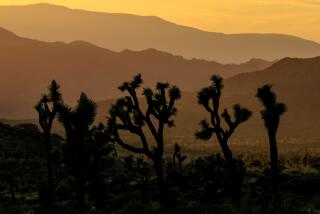Wildflowers, Joshua Trees Are Bursting Into Bloom
With the exception of pathfinder John C. Fremont, who called them “the most repulsive tree in the vegetable kingdom,” most California travelers have found Joshua trees to be quite picturesque. Mormon pioneers thought that the tree’s outstretched limbs and bearded appearance resembled the prophet Joshua pointing the way to the promised land.
The Joshuas have burst into an early bloom, and any doubts about the tree’s beauty will vanish if you walk among them. The clusters of creamy white flowers and the twisted limbs holding dagger-like leaves are a sight to behold.
“After a couple of dry years, we finally got a relatively wet one, which translates into a lot of desert bloom,” explains Joshua Tree National Park ranger Bob Raver. “Not only are the Joshuas in fine bloom, but it’s also a pretty good year for wildflowers.”
Flowers in Bloom
Desert dandelions, Mojave yuccas, Mojave asters and bladderpods are in bloom, Raver reports. Even the humble creosote is crowned with whitish-yellow flowers. “There are about 25 to 30 flowers and bushes blooming this month in Joshua Tree National Monument. Check in at the park visitors center for the most up-to-the-minute report of what’s blooming where.”
Despite its harsh appearance, the Joshua tree, Yucca brevifolia, belongs to the lily family. Like lilies and other flowers, it must be pollinated to reproduce. The tegeticula moth does the job for the Joshua tree, which in turn provides seeds for the moth’s newly hatched larvae. During the evolutionary history of the Mojave Desert, the Joshua tree and the moth joined to produce more Joshua trees and more moths, a partnership that continues to this day.
The Joshua tree is a small world unto itself and supports the survival of a number of creatures. A multitude of insects swarm in and around the tree. Birds nest in its limbs and feed on the insects. Lizards take shelter under the fallen trees and limbs. Termites turn dead Joshuas to dust, and the tree returns to the earth.
Joshuas are found almost exclusively in the Mojave Desert from 2,500 to 5,000 feet. The higher elevations, the relatively cooler temperatures and more northerly latitude of the Mojave suit the Joshua better than the lower, dryer, hotter Colorado Desert. The trees grow at the foot of mountain slopes and capture the surface and ground water draining from higher elevations. Once in a while, you’ll see a Joshua tree clumsily embrace one of its fellows, but its water requirements usually keep it away from other trees.
This day hike tours some Joshua trees, visits an Indian cave and ascends Ryan Mountain for a nice view over the rocky wonderland of Joshua Tree National Monument. Ryan Mountain is named for the Ryan brothers, Thomas and Jep, who had a homestead at the base of the mountain. The view from atop Ryan Mountain is to be savored and is one of the finest in the national monument.
Directions to trailhead: From the Joshua Tree National Monument Visitor Center at Twentynine Palms, drive 8 miles south on Utah Trail Road (the main park road), keeping right at the Pinto “Y” junction and continuing another 8 miles to Sheep Pass Campground on your left. Continue 1 mile past the campground to the parking lot and signed trailhead for Ryan Mountain. You may also begin this hike from the Indian Cave turnout just up the road, but there isn’t too much trailhead parking there.
For more information about trails and spring flora in Joshua Tree National Monument, call the Visitor Center at (619) 367-7511.
The hike: The trail skirts the base of Ryan Mountain and passes through a lunar landscape of rocks and Joshua trees. The Joshua is categorized as an evergreen, although each year, much of its foliage withers, dies and falls off. When not in bloom, the hardy Joshuas near the trail would be better described as “everlasting” rather than evergreen.
Soon you intersect a well-worn side trail coming up from your right. If you like, follow this brief trail down to Indian Cave, typical of the kind of shelter sought by the nomadic Cahuilla and Serrano Indian clans that traveled through here.
Very Old Rocks
Continuing past the junction, Ryan Mountain Trail ascends moderately to steeply toward the peak. En route, you’ll pass some very old rocks that make up the core of this mountain and the nearby Little San Bernardino range. For eons, these rocks have, since their creation, been metamorphosed by heat and pressure into completely new types, primarily gneiss and schist. No one knows their exact age, but geologists believe that the rocks are several hundred million years old.
From atop Mt. Ryan (5,470 feet), you’re treated to a panoramic view of Lost Horse, Queen, Hidden and Pleasant valleys. There’s a lot of geological history in the rocks shimmering on the ocean of sand below.
Not all rocks you see are as ancient as the ones on Ryan Mountain. Middle-aged rocks, quartz monzonite predominating, are found at Hidden Valley, Jumbo Rocks and White Tank. Younger rocks made of basaltic lava are mere infants at less than 1 million years old and are found in Pleasant Valley.
When you’ve enjoyed the rock show, return the same way.
Ryan Mountain Trail
Ryan Mountain Trailhead to peak, three miles round trip; 700-foot elevation gain.
More to Read
Sign up for The Wild
We’ll help you find the best places to hike, bike and run, as well as the perfect silent spots for meditation and yoga.
You may occasionally receive promotional content from the Los Angeles Times.






